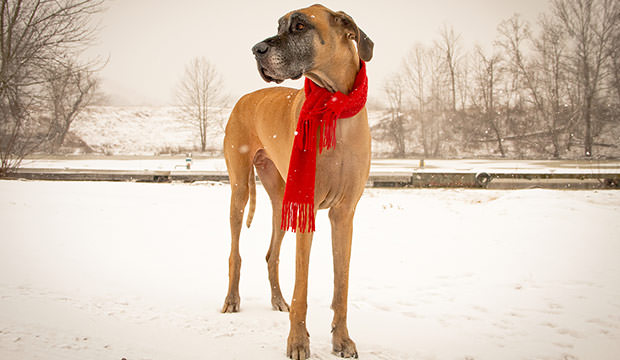
Only this breed can manage to look dignified and noble while being absolutely huge. These gentle giants of the canine world accompanied Asiatic tribes when they invaded Germany in 400 AD, and over the next few centuries, protected their humans by fighting off large beasts like bears and boars.
The Deutsche Dogge or, as they’re commonly known, the Great Dane further evolved from their mastiff-like physique when they were bred with other breeds (like Irish Greyhounds).
Great Danes are the perfect four-legged family member – they’re loving, affectionate, playful, and generally calm.
They do tend to be unaware of their immense size and robust strength, so don’t be surprised if your beloved gentle giant jumps in your lap and knocks you (and the couch) down. Uniquely gifted with a lot of mental and physical strengths, these pups are the perfect choice for active, sporty, and strong singles, but they also fit amazingly well into families that have older children.
They’re incredibly loyal and protective. They don’t bark much, when they do – your whole neighborhood will be aware that something fishy is going on. Apart from their vocal intimidation skills, their size and strength will be reason enough for intruders of all kinds to stay far away from your home.
Easygoing, yet stubborn, this breed must demands proper training from a young age, unless you want them to completely wreck your entire house. Although they’re as mellow as a dog can get, and absolutely cuddly and loving, they can cause a lot of damage to furniture and gardens if not trained. Speaking of accommodation, it’s pretty obvious that Great Danes are enormous dogs who need a lot of space. Apartments and houses without a backyard are a complete no-no.
Their common health issues include hip dysplasia, bloat and congenital heart disease, but if healthy, they can live up to 13 years. Make sure to take them to check-ups on a regular basis, though. When it comes to taking care of their outsides, Great Danes need regular brushing and grooming if you want to maintain their elegant, tall, powerful presence on point. Regular inspections of the ears, feet, nose, and eyes on a weekly basis will keep them tidy and healthy.
